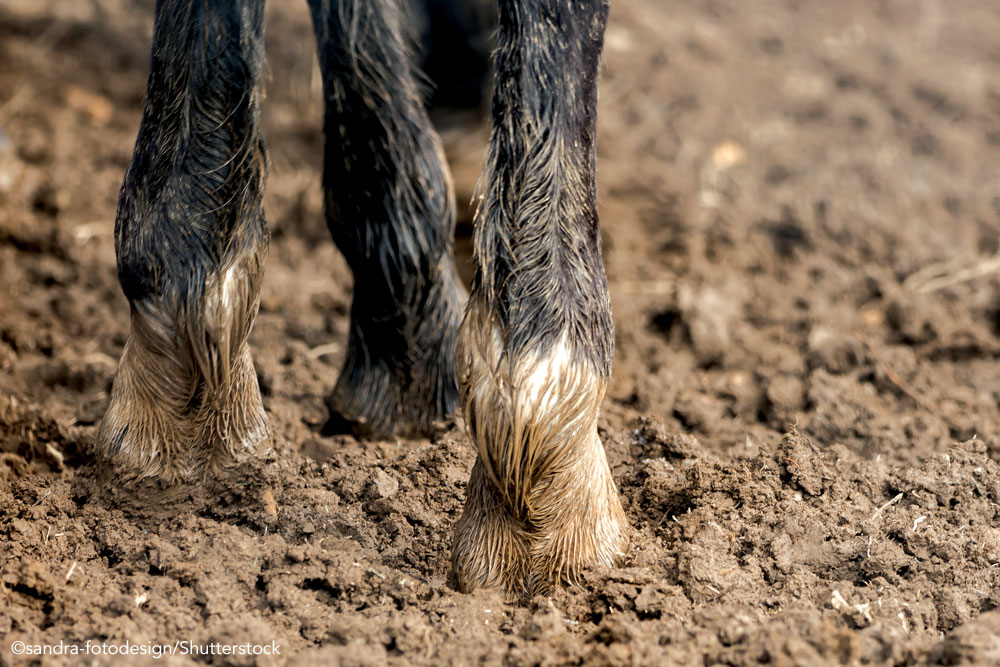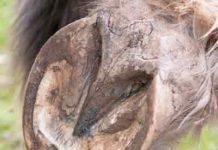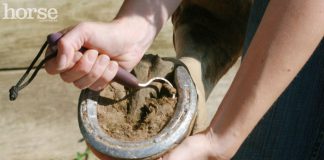Everyone’s heard of thrush in a hoof, but not everyone has seen it. More likely, they would smell it first. The unpleasant smell of a thrush-infected hoof can send you reeling in the middle of a grooming session. Opening an infected horse’s stall door is an instant reminder that his hooves need treatment.

Treating thrush is not something you want to put off. The next note from your farrier may be “Call the vet—serious thrush!” and you may even find your horse showing signs of lameness.
Here is a refresher course on what thrush is and how simple it is for you to do something about it.
Thrush is Everywhere
Thrush is probably the most common problem that horse owners encounter in their horses’ hooves. In a 2017 study published in the Preventive Veterinary Medicine journal, veterinary researchers from Utrecht University in The Netherlands worked with farriers to collect data on hoof problems. They found that 85 percent of the 942 horses in the study had at least one hoof problem, and that 45 percent of those suffered from thrush.
While thrush is linked to dirty stall bedding, muddy paddocks, and wet climates, it’s found even in dry environments. When farrier Shane Westman moved from Washington state to sunny, dry California to take over the farrier shop at the UC Davis School of Veterinary Medicine’s Large Animal Hospital, he thought he’d no longer need his well-developed expertise in thrush.
He was mistaken. “Oh, it’s here, too,” he says. “But it’s more clandestine.” Washington horses may have good reason to suffer from thrush in their muddy pastures, but why is it common in California?
“That’s easy,” says Westman. “Neglect. People don’t clean their horse’s feet.”
We may have the cleanest and best cared-for horses in the history of America, but their feet are still dirty, farriers across the country say. Our penchant for repeated bathing of horses may create more moisture in the foot than we realize, but farriers and veterinarians alike report a bigger problem: Daily hoof cleaning is being neglected.
“Your horse isn’t clean until his feet are picked out,” one farrier says. “It doesn’t matter what shampoo you use to try to make your horse smell nice if his feet stink.”

Treatment Plan
At some point, either your farrier warns you about thrush, or you recognize it yourself. You’re now standing in a store, looking at the shelf of thrush remedies. Do you want a spray, a gel, a liquid, or one of the new clay treatments?
Try this experiment: Go into the tack room of any boarding barn. Give the thrush treatment bottles a shake. Usually, they’re at least half full.
Selling a bottle of thrush medication is easy. But selling a second bottle is tougher because so many people stop treating thrush as soon as it starts to clear up.
To defeat thrush, you need a plan of action. For starters, look at your horse’s environment. Where does he spend most of his day—in a paddock? In a stall? What is the ground like in his turnout area, and what can you do to improve it?
If thrush is new to your horse, have you changed something in his routine? Have you switched bedding? Is he spending more time turned out (or kept in)? Are you bathing him more? Has rainfall been high in your area?
Many changes in a horse’s surroundings can affect the likelihood of thrush, but the most controllable factor is the person caring for the horse, and whether that person is cleaning the feet.
How to Clean a Foot
Walk through a boarding or lesson barn and watch people care for their horses: Some clean the feet, others don’t. Some make excuses for not picking out the hind feet. “Oh, he hates to pick up his hinds,” they say. But the longer a horse isn’t asked to pick them up, the less likely he is to want to do it.
And if the thrush gets worse, picking up the feet will be required, and often.
Some people are very fast. They quickly graze the foot with a hoof pick. They don’t turn the foot up to look at the frog. Proper hoof cleaning means inserting the hoof pick into the sulci on both sides of the frog and drawing it from the back of the foot to the point of the frog, down and away from the heels.
Once the foot is clean—and only then—it’s time to apply anti-thrush treatment to the frog.
Don’t Ignore It
Common thrush should be easy to cure, but haphazard treatment or ignoring the problem can lead to a severe infection that eventually makes a horse lame, or at least causes him to alter his gait or posture to relieve pressure on painful tissue.
Additionally, there are several types of infections that can attack a horse’s feet. Thrush is only one. Canker, known to your veterinarian as equine proliferative pododermatitis, is a very serious hoof problem that smells even worse than thrush and forms ugly, tumor-like growths on the frog or heels.
When the frog is eaten away by thrush, be prepared: your horse may jerk his foot away if he feels the hoof pick. The thrushy horse may feel pain when landing in a stride or after a jump. You may notice him refusing to change leads or preferring to get off a trail to walk on softer ground.
The deep split between thrushy heel bulbs is called “deep sulcus thrush.” The horse’s heels may move independently, leading the infection to spread to critical inner tissue. Your farrier might decide to shock you by inserting a tongue depressor deep between the heel bulbs to illustrate the damage.
A typical treatment involves the farrier or veterinarian “flossing” between the heel bulbs with a piece of gauze soaked in a disinfecting medication.
Farriers often solve the problem of frog deterioration or the deep sulcus split by applying a bar shoe. This will add to your monthly expenses, but it’s very important to conquer the thrush and help the hoof heal. Your veterinarian may apply antibiotic medication into the frog sulcus.
Wouldn’t it have been easier to keep the feet clean and dry, or at least be proactive at the first sign of thrush? It’s better to stomp it out early than pay the veterinarian and farrier to treat it later.
This article originally appeared in the February 2019 issue of Horse Illustrated magazine. Click here to subscribe!





